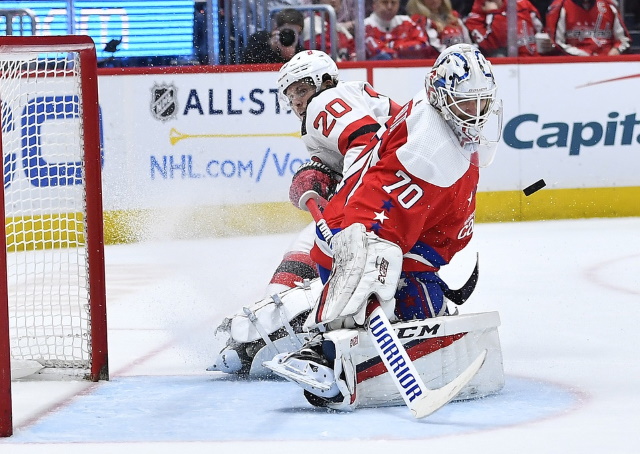Nikita Gusev living up to the hype while some other Devils haven’t
Former New Jersey Devils GM Ray Shero was as active as anyone this past summer. He made a ton of notable moves in an effort to help the team take the next step.
Unfortunately, not many of them panned out.
P.K. Subban averaged ~50 points per 82 games in three seasons prior to 2019-20. He was supposed to anchor the Devils’ defense. He is, I guess, but not in the way intended. Subban’s producing points at an 18-point pace and owns the worst 5v5 goal differential on the Devils blueline.
While Jack Hughes has shown flashes, and I still very much believe he was the right pick at No. 1 overall, he’s also been in and out of the lineup with injuries and is producing at a 37-point pace over a full schedule.
Wayne Simmonds signed a one-year deal to give the Devils more grit, scoring punch, and rehabilitate his career after an injury-plagued 2018-19 campaign. He is scoring at a seven-goal pace, the lowest of his NHL career.
Not great.
Shero did make one move that’s turned out as well – if not better – than expected at the time: trading for Nikita Gusev.
The 27-year-old Russian winger’s play was admittedly a little patchy out of the gate but he’s flourished big-time since finding a full-time home on a line with Travis Zajac and Blake Coleman.
Gusev leads the Devils in assists (19) and is tied for 3rd in points (27). Almost all of them have come at 5v5, where he’s quietly been one of the better offensive players in the league. No, seriously.
He has amassed 22 points at 5v5. That ties him for 45th among forwards, ahead of stars like Alex Ovechkin, Blake Wheeler, Johnny Gaudreau, Sebastian Aho, John Tavares and Taylor Hall.
His efficiency numbers are somehow even better. Gusev is averaging 2.88 points per 60 minutes played, 8th most in the NHL.
Only Evgeni Malkin, Artemi Panarin, Brad Marchand, Nathan MacKinnon, Jonathan Huberdeau, Bryan Rust, Jakub Vrana have produced at a higher clip.
Gusev’s primary center is a 34-year-old Travis Zajac, who is on pace for 30 points, and he’s still putting up points at a rate very few have matched.
Suffice to say, he is well worth the 2nd and 3rd round picks it cost the Devils to land him from the Vegas Golden Knights.
Braden Holtby a puzzling All-Star selection
The four divisional rosters were recently finalized for All-Star Weekend in St. Louis.
While the odd choice here and there could be nitpicked, for the most part, I think the league – and fan voters – made very reasonable selections. With one exception, of course. Washington Capitals goaltender Braden Holtby.
On the surface, it’s not hard to see why he was chosen. He’s a big name, and he’s the starting goaltender for the No. 1 seed in the league. That doesn’t mean he deserves the nod, though.
Simply put, Holtby has not performed at a high-level this season. Heck, he hasn’t even performed at an *average* level. And no, that’s not an exaggeration.
Holtby owns a highly underwhelming .899 save percentage across all situations. League average is .904.
He has a GSAA (Goals Saved Above Average) number of -8.59. Only six netminders have fared worse in that regard.
Holtby has given the Capitals a quality start in less than half of his games. His Quality Start% of 47% is well below the league average (53%) and his career average (57%).
If we isolate 5v5 play, where most of every game is spent and the playing field is level, Holtby’s numbers still paint a pretty ugly picture.
Of 53 eligible goaltenders (700+ minutes), Holtby ranks 46th in save percentage, 47th in high-danger save percentage, and 48th in GSAA.
He’s been a complete disappointment regardless of which metric you’re looking at. That Ilya Samsonov is among the league leaders in pretty much all of them while playing behind the same defense only makes Holtby look worse.
Holtby is not playing like one of the better goaltenders in the division. He’s not even playing like the best goaltender on his own team.
He should not be an All-Star.
Numbers via NaturalStatTrick.com and Hockey-Reference.com
Follow me on Twitter @ToddCordell



